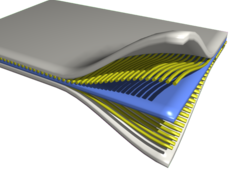Polymer chemistry
Polymer chemistry (also called macromolecular chemistry) is the science of chemical synthesis and chemical properties of polymers or macromolecules.[1] According to IUPAC recommendations,[2][3] macromolecules refer to the individual molecular chains and are the domain of chemistry. Polymers describe the bulk properties of polymer materials and belong to the field of polymer physics (a part of physics).
The different kinds of macromolecules include:
- Biopolymers produced by living organisms:
- structural proteins: collagen, keratin, elastin and others
- chemically functional proteins: enzymes, hormones, transport proteins and others
- structural polysaccharides: cellulose, chitin and others
- storage polysaccharides: starch, glycogen and others
- nucleic acids: DNA, RNA
- Synthetic polymers used for plastics—fibers, paints, building materials, furniture, mechanical parts, adhesives:
- thermoplastics: polyethylene, Teflon, polystyrene, polypropylene, polyester, polyurethane, polymethyl methacrylate, polyvinyl chloride, nylon, rayon, celluloid, silicone and others
- thermosetting plastics: vulcanized rubber, Bakelite, Kevlar, epoxy and others.
Polymers are formed by polymerization of monomers. Chemists describe a polymer by its degree of polymerization, molar mass distribution, tacticity, copolymer distribution, the degree of branching, by its end-groups, crosslinks, and crystallinity. Chemists also study a polymer's thermal properties such as its glass transition temperature and melting temperature. Polymers in solution have special characteristics for solubility, viscosity and gelation.
History
Polymer chemistry started by studying the long fibers in plants. The work of Henri Braconnot in 1777 and the work of Christian Schönbein in 1846 led to the discovery of nitrocellulose. Nitrocellulose treated with camphor makes celluloid. Chemists dissolve celluloid in ether or acetone to make collodion. Doctors have used collodion as a wound dressing since the U.S. Civil War. Cellulose acetate was first prepared in 1865. In 1834, Friedrich Ludersdorf and Nathaniel Hayward independently discovered that adding sulfur to raw natural rubber (polyisoprene) helped prevent the material from becoming sticky. In 1844 Charles Goodyear received a U.S. patent for vulcanizing rubber with sulfur and heat. Thomas Hancock had received a patent for the same process in the UK the year before.
In 1884, Hilaire de Chardonnet started the first artificial fiber factory based on regenerated cellulose, or viscose rayon, as a substitute for silk, but it was very flammable.[4] In 1907 Leo Baekeland invented the first synthetic polymer, a thermosetting phenol-formaldehyde resin called Bakelite. Around the same time, Hermann Leuchs reported the synthesis of N-carboxyanhydrides and their high molecular weight products upon reaction with nucleophiles. But Leuchs did not call them polymers, possibly due to the strong views held by Emil Fischer, his direct supervisor, denying the possibility of any covalent molecule exceeding 6,000 daltons.[5] Cellophane was invented in 1908 by Jocques Brandenberger who squirted sheets of viscose rayon into an acid bath.[6]
In 1922, Hermann Staudinger (a German chemist) proposed that polymers were long chains of atoms held together by covalent bonds. He also proposed to name these compounds "macromolecules". Before that, scientists believed that polymers were clusters of small molecules (called colloids), without definite molecular weights, held together by an unknown force. Staudinger received the Nobel Prize in Chemistry in 1953.
Wallace Carothers invented the first synthetic rubber called neoprene in 1931. Neoprene was the first polyester. Carothers went on to invent nylon, a true silk replacement, in 1935. Paul Flory was awarded the Nobel Prize in Chemistry in 1974 for his work on polymer random coil configurations in solution in the 1950s. Stephanie Kwolek developed an aramid, or aromatic nylon named Kevlar, patented in 1966.[7]
There are now a large number of commercial polymers. They include composite materials such as carbon fiber-epoxy, polystyrene-polybutadiene (HIPS), acrylonitrile-butadiene-styrene (ABS). Chemists design commercial polymers to combine the best properties of their various components. For example, special polymers used in automobile engines are designed to work at high temperatures.
It took a long time before universities introduced teaching and research programs in polymer chemistry. An "Institut fur Makromolekulare Chemie was founded in 1940 in Freiburg, Germany under the direction of Hermann Staudinger. In America a "Polymer Research Institute" (PRI) was established in 1941 by Herman Mark at the Polytechnic Institute of Brooklyn (now Polytechnic Institute of NYU). Several hundred graduates of PRI played an important role in the US polymer industry and academia. Other PRI's were founded in 1961 by Richard S. Stein at the University of Massachusetts, Amherst, in 1967 by Eric Baer at Case Western Reserve University and in 1988 at the University of Akron.
Polymer Chemistry Media
Portion of backbone of nylon 6,6.
Structures of some electrically conductive polymers: polyacetylene; polyphenylene vinylene; polypyrrole (X = NH) and polythiophene (X = S); and polyaniline (X = NH/N) and polyphenylene sulfide (X = S).
Structure of polydimethylsiloxane, illustrating a polymer with an inorganic backbone.
The viscosity of polymer solutions is a valued parameter. Viscometers such as this are employed in such measurements.
Segments of polypropylene, showing the slightly different structures of isotactic (above) and syndiotactic (below) polymers.
A strand of cellulose showing the hydrogen bonds (dashed) within and between the chains.
Hermann Staudinger, father of polymer chemistry
Wallace Carothers, inventor of nylon.
Stephanie Kwolek, inventor of Kevlar.
References
- ↑ Ravve, Abe (2000). Principles of Polymer Chemistry (Second ed.). Plenum Publishing. ISBN 9780306463686.
- ↑ "Macromolecule". IUPAC. Retrieved 2011-09-05.
- ↑ "Polymer". IUPAC. Retrieved 2011-09-05.
- ↑ "The Early Years of Artificial Fibres". The Plastics Historical Society. Retrieved 2011-09-05.
- ↑ Kricheldorf, Hans, R. (2006), "Polypeptides and 100 Years of Chemistry of α-Amino Acid N-Carboxyanhydrides", Angewandte Chemie International Edition, 45 (35): 5752–5784, doi:10.1002/anie.200600693, PMID 16948174
- ↑ "History of Cellophane". about.com. Archived from the original on 2020-06-02. Retrieved 2011-09-05.
- ↑ "The History of Kevlar". about.com. Retrieved 2011-09-05.[dead link]







